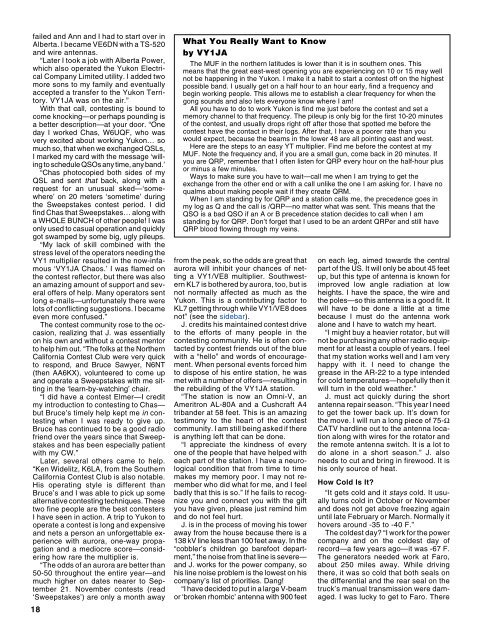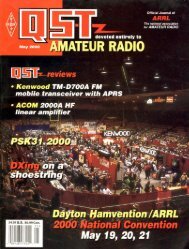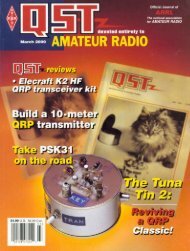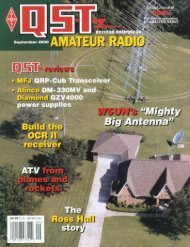September/October 2000 NCJ
September/October 2000 NCJ
September/October 2000 NCJ
You also want an ePaper? Increase the reach of your titles
YUMPU automatically turns print PDFs into web optimized ePapers that Google loves.
failed and Ann and I had to start over inAlberta. I became VE6DN with a TS-520and wire antennas.“Later I took a job with Alberta Power,which also operated the Yukon ElectricalCompany Limited utility. I added twomore sons to my family and eventuallyaccepted a transfer to the Yukon Territory.VY1JA was on the air.”With that call, contesting is bound tocome knocking—or perhaps pounding isa better description—at your door. “Oneday I worked Chas, W6UQF, who wasvery excited about working Yukon… somuch so, that when we exchanged QSLs,I marked my card with the message ‘willingto schedule QSOs any time, any band.’“Chas photocopied both sides of myQSL and sent that back, along with arequest for an unusual sked—‘somewhere’on 20 meters ‘sometime’ duringthe Sweepstakes contest period. I didfind Chas that Sweepstakes… along witha WHOLE BUNCH of other people! I wasonly used to casual operation and quicklygot swamped by some big, ugly pileups.“My lack of skill combined with thestress level of the operators needing theVY1 multiplier resulted in the now-infamous‘VY1JA Chaos.’ I was flamed onthe contest reflector, but there was alsoan amazing amount of support and severaloffers of help. Many operators sentlong e-mails—unfortunately there werelots of conflicting suggestions. I becameeven more confused.”The contest community rose to the occasion,realizing that J. was essentiallyon his own and without a contest mentorto help him out. “The folks at the NorthernCalifornia Contest Club were very quickto respond, and Bruce Sawyer, N6NT(then AA6KX), volunteered to come upand operate a Sweepstakes with me sittingin the ‘learn-by-watching’ chair.“I did have a contest Elmer—I creditmy introduction to contesting to Chas—but Bruce’s timely help kept me in contestingwhen I was ready to give up.Bruce has continued to be a good radiofriend over the years since that Sweepstakesand has been especially patientwith my CW.”Later, several others came to help.“Ken Widelitz, K6LA, from the SouthernCalifornia Contest Club is also notable.His operating style is different thanBruce’s and I was able to pick up somealternative contesting techniques. Thesetwo fine people are the best contestersI have seen in action. A trip to Yukon tooperate a contest is long and expensiveand nets a person an unforgettable experiencewith aurora, one-way propagationand a mediocre score—consideringhow rare the multiplier is.“The odds of an aurora are better than50-50 throughout the entire year—andmuch higher on dates nearer to <strong>September</strong>21. November contests (read‘Sweepstakes’) are only a month away18What You Really Want to Knowby VY1JAThe MUF in the northern latitudes is lower than it is in southern ones. Thismeans that the great east-west opening you are experiencing on 10 or 15 may wellnot be happening in the Yukon. I make it a habit to start a contest off on the highestpossible band. I usually get on a half hour to an hour early, find a frequency andbegin working people. This allows me to establish a clear frequency for when thegong sounds and also lets everyone know where I am!All you have to do to work Yukon is find me just before the contest and set amemory channel to that frequency. The pileup is only big for the first 10-20 minutesof the contest, and usually drops right off after those that spotted me before thecontest have the contact in their logs. After that, I have a poorer rate than youwould expect, because the beams in the lower 48 are all pointing east and west.Here are the steps to an easy YT multiplier. Find me before the contest at myMUF. Note the frequency and, if you are a small gun, come back in 20 minutes. Ifyou are QRP, remember that I often listen for QRP every hour on the half-hour plusor minus a few minutes.Ways to make sure you have to wait—call me when I am trying to get theexchange from the other end or with a call unlike the one I am asking for. I have noqualms about making people wait if they create QRM.When I am standing by for QRP and a station calls me, the precedence goes inmy log as Q and the call is /QRP—no matter what was sent. This means that theQSO is a bad QSO if an A or B precedence station decides to call when I amstanding by for QRP. Don’t forget that I used to be an ardent QRPer and still haveQRP blood flowing through my veins.from the peak, so the odds are great thataurora will inhibit your chances of nettinga VY1/VE8 multiplier. SouthwesternKL7 is bothered by aurora, too, but isnot normally affected as much as theYukon. This is a contributing factor toKL7 getting through while VY1/VE8 doesnot” (see the sidebar).J. credits his maintained contest driveto the efforts of many people in thecontesting community. He is often contactedby contest friends out of the bluewith a “hello” and words of encouragement.When personal events forced himto dispose of his entire station, he wasmet with a number of offers—resulting inthe rebuilding of the VY1JA station.“The station is now an Omni-V, anAmeritron AL-80A and a Cushcraft A4tribander at 58 feet. This is an amazingtestimony to the heart of the contestcommunity. I am still being asked if thereis anything left that can be done.“I appreciate the kindness of everyone of the people that have helped witheach part of the station. I have a neurologicalcondition that from time to timemakes my memory poor. I may not rememberwho did what for me, and I feelbadly that this is so.” If he fails to recognizeyou and connect you with the giftyou have given, please just remind himand do not feel hurt.J. is in the process of moving his toweraway from the house because there is a138 kV line less than 100 feet away. In the“cobbler’s children go barefoot department,”the noise from that line is severe—and J. works for the power company, sohis line noise problem is the lowest on hiscompany’s list of priorities. Dang!“I have decided to put in a large V-beamor ‘broken rhombic’ antenna with 900 feeton each leg, aimed towards the centralpart of the US. It will only be about 45 feetup, but this type of antenna is known forimproved low angle radiation at lowheights. I have the space, the wire andthe poles—so this antenna is a good fit. Itwill have to be done a little at a timebecause I must do the antenna workalone and I have to watch my heart.“I might buy a heavier rotator, but willnot be purchasing any other radio equipmentfor at least a couple of years. I feelthat my station works well and I am veryhappy with it. I need to change thegrease in the AR-22 to a type intendedfor cold temperatures—hopefully then itwill turn in the cold weather.”J. must act quickly during the shortantenna repair season. “This year I needto get the tower back up. It’s down forthe move. I will run a long piece of 75-ΩCATV hardline out to the antenna locationalong with wires for the rotator andthe remote antenna switch. It is a lot todo alone in a short season.” J. alsoneeds to cut and bring in firewood. It ishis only source of heat.How Cold Is It?“It gets cold and it stays cold. It usuallyturns cold in <strong>October</strong> or Novemberand does not get above freezing againuntil late February or March. Normally ithovers around -35 to -40 F.”The coldest day? “I work for the powercompany and on the coldest day ofrecord—a few years ago—it was -67 F.The generators needed work at Faro,about 250 miles away. While drivingthere, it was so cold that both seals onthe differential and the rear seal on thetruck’s manual transmission were damaged.I was lucky to get to Faro. There
















